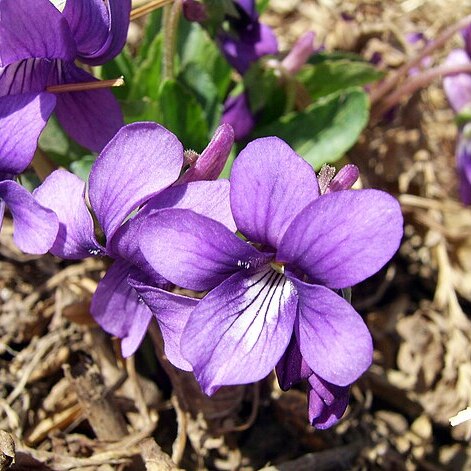Herbs perennial, acaulescent, 4-14 cm tall, to 20 cm tall at fruiting. Rhizome erect, brownish, short, 4-13 mm, 2-7 mm in diam., densely noded, with several yellowish or whitish rootlets. Leaves numerous, basal, rosulate; stipules glaucous or greenish, 1.5-2.5 cm, membranous, 2/3-4/5 adnate to petioles, free part linear-lanceolate, margin remotely glandular fimbriate-denticulate or subentire; petiole usually 1-2 × exceeding blades at anthesis, very narrowly winged in upper part, to 10 cm at fruiting, broadly winged in upper part, puberulous or glabrous; upper blades oblong-lanceolate or triangular-ovate, usually smaller than lower ones; lower ones oblong, narrowly ovate-lanceolate, or oblong-ovate, 1.5-4 × 0.5-1 cm, both surfaces glabrous or puberulous, sometimes only puberulous along veins abaxially, base truncate or cuneate, rarely slightly cordate, margin shallowly crenate, apex obtuse; blades accrescent at fruiting, to 10 × 4 cm. Flowers purple-violet or purplish, rarely white, light colored and purple-striate at throat, medium-sized; pedicels usually numerous, equaling or exceeding leaves, slender, glabrous or puberulous, 2-bracteolate near middle; bracteoles linear. Sepals ovate to ovate-lanceolate, 3-7 × 0.7-1.8 mm, apex acuminate; appendages short, 1-1.5 mm, 1/2 to 1/6 as long as sepal, glabrous or sparsely pubescent, apex rounded or denticulate. Petals obovate or oblong-obovate, lateral ones 1-1.2 cm, inside glabrous or rarely lightly bearded, anterior one 1.3-2 cm (spur included), inside purple-veined; spur tubular, 3-8 mm, 2-5 × as long as calycine appendages; anthers ca. 2 mm, appendage of connectives ca. 1.5 mm; spur of 2 anterior stamens tubular, 3-6 mm, apex slender. Ovary ovoid, glabrous; styles clavate, slightly exceeding ovary, base slightly geniculate; stigmas triangular with slightly thickened and raised margins on lateral sides and abaxially, slightly flat at top, shortly beaked in front. Capsule ellipsoid, 5-12 mm, glabrous. Seeds yellowish, ovoid-globose, ca. 1.8 mm. Fl. Apr-May, fr. May-Sep. 2n = 24*, 48.
More
Perennial; rhizome vertical or suboblique, rather slender, bearing rosette of leaves and flowers at apex, acaulescent. Leaves 1-4 by ½-3 cm, 1-2 times as long as broad, ovate-elliptic to ovate or triangular-hastate, deeply to shallowly cordate to subtruncate at base, with the basal lobes usually somewhat converging, obtuse to rounded, round-crenate to crenate-serrate, usually long-decurrent on petiole, glabrous or puberulent beneath on veins and margins; petiole 1-6 cm. Stipules 2-8 by 0.8-3 mm, ovate-lanceolate, acute, shortly fimbrio-dentate, glabrous or sparsely pubescent, green to rather fuscous, adnate to petiole to ¾ length. Flowers 9½-14½ mm, pale to dark violet; peduncle usually much exceeding leaves, glabrous or puberulent distally. Sepals 3-5.2 by 0.7-1.8 mm, ovate to ovate-lanceolate, acute or rounded entire, glabrous or ciliolate, green with scarious margin; appendage ½-2 mm, (½-)⅓-1/6 as long as sepal, rounded to denticulate, glabrous or sparsely pubescent. Petals 1.2-3½ times as long as broad, obovate, the laterals not or lightly bearded; spur 2½-6 mm, 2-4 times as long as broad, 2-5 times as long as calycine appendages, usually slightly tapering and downwards curving. Style 1½-2.4 mm, geniculate at base, clavate distally, apex with prominent lateral lobes partially fused behind, anterior stigmatic beak. Capsule 5-8 mm, ellipsoid, glabrous.

